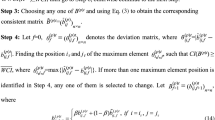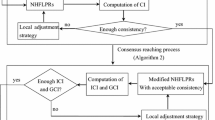Abstract
This research focuses on group decision making (GDM) under hesitant fuzzy condition. All experts (decision makers) are allowed to use hesitant fuzzy preference relations (HFPRs) to express their opinions. Subsequently, a dynamically expert contribution-based consensus model is developed for GDM with HFPRs. In the proposed method, a combination of a weight update model and a preference adjustment model is applied to consensus reaching processes (CRPs). In the weight update model, we propose to dynamically update experts’ weights according to their contributions in the CRPs. In the preference adjustment model, only the preferences which are far away from the expected values are modified, aiming to retain the experts’ original information as much as possible. Finally, the proposed model is applied to water resources allocation selection to show how it works in practice. And some comparisons and discussions are given to show the advantages of the proposed method.




Similar content being viewed by others
References
Ben-Arieh D, Chen ZF (2006) Linguistic-labels aggregation and consensus measure for autocratic decision making using group recommendations. IEEE Trans Syst Man Cybern Part A Syst Hum 36:558–568
Cabrerizo FJ, Alonso S, Herrera-Viedma E (2009) A consensus model for group decision making problems with unbalanced fuzzy linguistic information. Int J Inf Technol Decis Mak 8:109–131
Cheng HF, Hu YA, Zhao JF (2009) Meeting China’s water shortage crisis: current practices and challenges. Environ Sci Technol 43:240–244
Del Moral MJ, Tapia JM, Chiclana F, Al-Hmouz A, Herrera-Viedma E (2018) An analysis of consensus approaches based on different concepts of coincidence. J Intell Fuzzy Syst 34:2247–2259
Dong YC, Xu YF, Li HY (2008) On consistency measures of linguistic preference relations. Eur J Oper Res 189:430–444
Dong YC, Zhang GQ, Hong WC, Xu YF (2010) Consensus models for AHP group decision making under row geometric mean prioritization method. Decis Support Syst 49:281–289
Dong YC, Zha QB, Zhang HJ, Kou G, Fujita H, Chiclana F, Herrera-Viedma E (2018a) Consensus reaching in social network group decision making: research paradigms and challenges. Knowl Based Syst 162:3–13
Dong YC, Zhao SH, Zhang HJ, Chiclana F, Herrera-Viedma E (2018b) A self-management mechanism for noncooperative behaviors in large-scale group consensus reaching processes. IEEE Trans Fuzzy Syst 26:3276–3288
Giordano R, Passarella G, Uricchio VF, Vurro M (2007) Integrating conflict analysis and consensus reaching in a decision support system for water resource management. J Environ Manag 84:213–228
Gong ZW, Xu XX, Zhang HH, Aytun Ozturk U, Herrera-Viedma E, Xu C (2015) The consensus models with interval preference opinions and their economic interpretation. Omega 55:81–90
Hanjra MA, Qureshi ME (2010) Global water crisis and future food security in an era of climate change. Food Policy 35:365–377
Herrera F, Herrera-Viedma E, Verdegay JL (1997) Linguistic measures based on fuzzy coincidence for reaching consensus in group decision making. Int J Approx Reason 16:309–334
Herrera-Viedma E, Alonso S, Chiclana F, Herrera F (2007) A consensus model for group decision making with incomplete fuzzy preference relations. IEEE Trans Fuzzy Syst 15:863–877
Kacprzyk J (1986) Group decision making with a fuzzy linguistic majority. Fuzzy Sets Syst 18:105–118
Li GX, Kou G, Peng Y (2016) A group decision making model for integrating heterogeneous information. IEEE Trans Syst Man Cybern Syst 48:982–992
Liu X, Xu YJ, Montes R, Ding R-X, Herrera F (2018a) Alternative ranking-based clustering and reliability index-based consensus reaching process for hesitant fuzzy large scale group decision making. IEEE Trans Fuzzy Syst 27:159–171
Liu YT, Dong YC, Liang HM, Chiclana F, Herrera-Viedma E (2018b) Multiple attribute strategic weight manipulation with minimum cost in a group decision making context with interval attribute weights information. IEEE Trans Syst Man Cybern Syst. https://doi.org/10.1109/TSMC.2018.2874942
Liu X, Xu YJ, Herrera F (2019a) Consensus model for large-scale group decision making based on fuzzy preference relation with self-confidence: detecting and managing overconfidence behaviors. Inf Fusion 52:245–256
Liu X, Xu YJ, Montes R, Dong YC, Herrera F (2019b) Analysis of self-confidence indices-based additive consistency for fuzzy preference relations with self-confidence and its application in group decision making. Int J Intell Syst 34:920–946
Loucks DP, Gladwell JS (1999) Sustainability criteria for water resource systems. Cambridge University Press, Cambridge
Millet I (1997) The effectiveness of alternative preference elicitation methods in the analytic hierarchy process. J Multi-Criteria Decis Anal 6:41–51
Morais DC, de Almeida AT (2012) Group decision making on water resources based on analysis of individual rankings. Omega 40:42–52
Morente-Molinera JA, Kou G, Peng Y, Torres-Albero C, Herrera-Viedma E (2018) Analysing discussions in social networks using group decision making methods and sentiment analysis. Inf Sci 447:157–168
Pérez IJ, Cabrerizo FJ, Alonso S, Dong Y, Chiclana F, Herrera-Viedma E (2018) On dynamic consensus processes in group decision making problems. Inf Sci 459:20–35
Rosegrant MW, Binswanger HP (1994) Markets in tradable water rights: potential for efficiency gains in developing country water resource allocation. World Dev 22:1613–1625
Torra V (2010) Hesitant fuzzy sets. Int J Intell Syst 25:529–539
Urena R, Kou G, Dong Y, Chiclana F, Herrera-Viedma E (2019) A review on trust propagation and opinion dynamics in social networks and group decision making frameworks. Inf Sci 478:461–475
Wang JF, Cheng GD, Gao YG, Long AH, Xu ZM, Li X, Chen HY, Barker T (2008) Optimal water resource allocation in arid and semi-arid areas. Water Resour Manag 22:239–258
Wu J, Chiclana F (2014) A social network analysis trust-consensus based approach to group decision-making problems with interval-valued fuzzy reciprocal preference relations. Knowl Based Syst 59:97–107
Wu WS, Kou G (2016) A group consensus model for evaluating real estate investment alternatives. Financ Innov 2:8
Wu ZB, Xu JP (2012a) A concise consensus support model for group decision making with reciprocal preference relations based on deviation measures. Fuzzy Sets Syst 206:58–73
Wu ZB, Xu JP (2012b) Consensus reaching models of linguistic preference relations based on distance functions. Soft Comput 16:577–589
Wu ZB, Xu JP (2015) Managing consistency and consensus in group decision making with hesitant fuzzy linguistic preference relations. Omega 65:28–40
Xia MM, Xu ZS (2011) Hesitant fuzzy information aggregation in decision making. Int J Approx Reason 52:395–407
Xia MM, Xu ZS (2013) Managing hesitant information in GDM problems under fuzzy and multiplicative preference relations. Int J Uncertainty, Fuzziness Knowl Based Syst 21:865–897
Xu ZS, Xia MM (2011) Distance and similarity measures for hesitant fuzzy sets. Inf Sci 181:2128–2138
Xu YJ, Zhang WC, Wang HM (2015) A conflict-eliminating approach for emergency group decision of unconventional incidents. Knowl Based Syst 83:92–104
Xu YJ, Chen L, Rodríguez RM, Herrera F, Wang HM (2016) Deriving the priority weights from incomplete hesitant fuzzy preference relations in group decision making. Knowl Based Syst 99:71–78
Xu YJ, Cabrerizo FJ, Herrera-Viedma E (2017a) A consensus model for hesitant fuzzy preference relations and its application in water allocation management. Appl Soft Comput 58:265–284
Xu YJ, Rui D, Wang HM (2017b) A dynamically weight adjustment in the consensus reaching process for group decision-making with hesitant fuzzy preference relations. Int J Syst Sci 48:1311–1321
Xu YJ, Liu X, Wang HM (2018a) The additive consistency measure of fuzzy reciprocal preference relations. Int J Mach Learn Cybern 9:1141–1152
Xu YJ, Wen XW, Zhang WC (2018b) A two-stage consensus method for large-scale multi-attribute group decision making with an application to earthquake shelter selection. Comput Ind Eng 16:113–129
Zhang ZM, Wu C (2014) A decision support model for group decision making with hesitant multiplicative preference relations. Inf Sci 282:136–166
Zhang ZM, Wang C, Tian XD (2015) A decision support model for group decision making with hesitant fuzzy preference relations. Knowl Based Syst 86:77–101
Zhang Z, Guo CH, Martínez L (2017) Managing multigranular linguistic distribution assessments in large-scale multiattribute group decision making. IEEE Trans Syst Man Cybern Syst 47:3063–3076
Zhu B, Xu ZS (2014) Consistency measures for hesitant fuzzy linguistic preference relations. IEEE Trans Fuzzy Syst 22:35–45
Zhu B, Xu ZS, Xu JP (2014) Deriving a ranking from hesitant fuzzy preference relations under group decision making. IEEE Trans Cybern 44:1328–1337
Acknowledgements
This work was partly supported by the Key Project of National Science Foundation of China (NSFC) (Grant No. 71433003), the Fundamental Research Funds for Central Universities (No. 2019B81514) and the National Natural Science Foundation of China (NSFC) (No. 71871085).
Author information
Authors and Affiliations
Corresponding author
Ethics declarations
Conflict of interest
The authors declare no conflict of interests.
Ethical approval
This article does not contain any studies with human participants or animals performed by any of the authors.
Informed consent
Informed consent was obtained from all individual participants included in the study.
Additional information
Communicated by V. Loia.
Publisher's Note
Springer Nature remains neutral with regard to jurisdictional claims in published maps and institutional affiliations.
Rights and permissions
About this article
Cite this article
Xu, Y., Liu, X. & Xu, L. A dynamic expert contribution-based consensus model for hesitant fuzzy group decision making with an application to water resources allocation selection. Soft Comput 24, 4693–4708 (2020). https://doi.org/10.1007/s00500-019-04229-3
Published:
Issue Date:
DOI: https://doi.org/10.1007/s00500-019-04229-3




